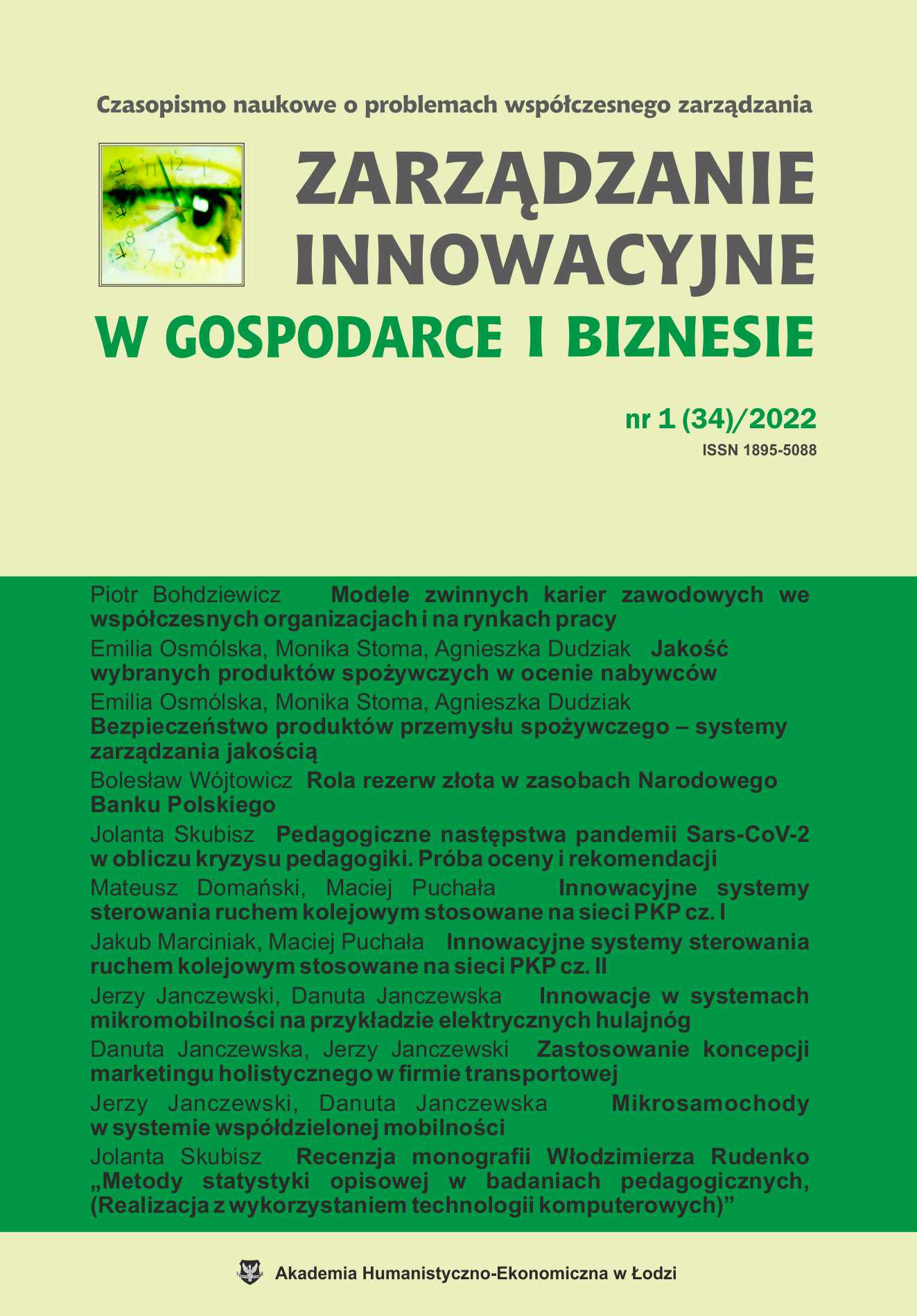Rola rezerw złota w zasobach Narodowego Banku Polskiego
DOI:
https://doi.org/10.25312/2391-5129.34/2022_04bwSłowa kluczowe:
bank centralny, rezerwy złotaAbstrakt
Artykuł stanowi dogłębne spojrzenie na funkcjonalność rezerw złota w Narodowym Banku Polskim. Stanowi jednocześnie próbę odpowiedzi na pytanie o ich celowość. Autor rozpoczyna od przedstawienia specyficznej odwróconej korelacji roli złota i dolara amerykańskiego, czyli poprzedniego i aktualnego nieoficjalnego aktywa rezerwowego świata. Stara się wyjaśnić przy tym indywidualną funkcjonalność każdego z nich w rezerwach banków centralnych oraz zaznacza konieczność dywersyfikacji. Nakreśla bardzo specyficzną negatywną korelację pomiędzy tymi dwoma aktywami, którymi są obecna i poprzednia nieoficjalna waluta rezerwowa świata. Następnie w pracy przedstawiono szczegółowy obraz aktywów posiadanych przez Narodowy Bank Polski oraz ich zmiany w ciągu ostatnich kilku lat. Rodzime rezerwy złota zaprezentowane są na tle kilku wybranych jurysdykcji wraz z komentarzem. Ważnym elementem pracy jest omówienie ostatnich regulacji Bazylea III i sposobu, w jaki zmieniły one rolę złota z aktywa spekulacyjnego na godne zaufania. Autor zarysowuje odwrócenie trendu sprzedażowego przez banki centralne oraz prawne rozdzielenie złota fizycznego i „papierowego”. Ustanawiając ramy formalno-prawne, autor skupia się na złocie w rezerwach polskiego banku centralnego. Przedstawia historyczne spojrzenie na to, jak zmieniały się one w latach 1939–2021, a następnie szczegółowo pokazuje, jak są one podzielone pomiędzy polskie skarbce i rynek londyński. Wyjaśnia powody takiej dywersyfikacji, a także podaje informacje o przyszłych deklarowanych zmianach wolumenu.
Konkluzją pracy jest to, że biorąc pod uwagę obecną sytuację na rynkach finansowych oraz trwający ponad dekadę trend w zakupach netto złota przez banki centralne, dywersyfikowanie aktywów w posiadaniu poprzez dodanie do nich złota należy uznać za logiczne i jednocześnie innowacyjne.
Pobrania
Bibliografia
Aktywa rezerwowe Polski w sierpniu 2022 r. (2022), https://www.nbp.pl/home.aspx?f=/aktualnosci/wiadomosci_2022/ rezerwy_sierpien_2022.ht ml [dostęp: 13.09.2021].
Berłowska B., Bezzubik B., Żaczek M. (2019), Reserves accumulation and diversification: the case of Poland, „BIS Papers”, nr 104.
Claessens S., Klingebiel D., Schmukler S. (2003), Government Bonds in Domestic and Foreign Currency, „Policy Research Working Paper”, nr 2986.
Currency Composition of Official Foreign Exchange Reserves (2021), https://data.imf.org/?sk=E6A5F467-C14B-4AA8-9F6D-5A09EC4E62A4 [dostęp: 1.01.2022].
Davies G. (2002), A History of Money – From Ancient Times to the Present Day, University of Wales Press, Cardiff.
Frączyk J. (2021), Ministerstwo Finansów planuje emisję obligacji na rynku chińskim. To może być nowe otwarcie w relacjach, https://businessinsider.com.pl/finanse/obligacje-chinskie-panda-bonds-ministerstwo-finansow-planuje-emisje-to-moze-byc-nowe/9eslf2z [dostęp: 18.01.2022].
Implementing Basel III in Europe (2021), https://www.eba.europa.eu/regulation-and-policy/implementing-basel-iii-europe [dostęp: 8.01.2022].
Kolejne 100 ton złota w 2022 roku (2021), https://www.nbp.pl/home.aspx?f=/aktualnosci/wiadomosci_2021/zloto2022.html [dostęp: 27.12.2021].
Konstytucja Rzeczypospolitej Polskiej z dnia 2 kwietnia 1997 r. uchwalona przez Zgromadzenie Narodowe w dniu 2 kwietnia 1997 r., Dz.U. 1997, nr 78, poz. 483.
LBMA Trade Data (2021), https://www.lbma.org.uk/prices-and-data/lbma-trade-data [dostęp: 10.01.2022].
Mandruzzato G. (2021), Gold and Basel III, https://www.efginternational.com/fr/insights/2021/gold-and-basel.html [dostęp: 27.12.2021].
Monthly central bank statistics (2021), https://www.gold.org/goldhub/data/monthly-central-bank-statistics [dostęp: 3.12.2021].
Morawski M. (2002), Zarys powszechnej historii pieniądza i bankowości, Trio, Warszawa.
Murau S., Rini J., Haas A. (2020), The evolution of the Offshore US-Dollar System: past, present and four possible futures, „Journal of Institutional Economics”, Vol. 16(6). DOI: https://doi.org/10.1017/S1744137420000168
Narodowy Bank Polski popiera pełne przyjęcie w UE zapisów pakietu Bazylea III (2021), https://www.nbp.pl/home.aspx?f=/aktualnosci/wiadomosci_2021/basel.html [dostęp: 29.12.2021].
Nugee J. (2017), Foreign exchange reserves management, https://www.bankofengland.co.uk/ccbs/foreign-exchange-reserves-management [dostęp: 27.12.2021].
Odpowiedź podsekretarza stanu w Ministerstwie Finansów – z upoważnienia ministra – na interpelację nr 26867 w sprawie polskich rezerw złota znajdujących się w Wielkiej Brytanii (2014), https://www.sejm.gov.pl/sejm7.nsf/InterpelacjaTresc.xsp?key=73C15193 [dostęp: 27.12.2021].
Polskie rezerwy złota (2019), https://www.cpnbp.pl/wystawa/wystawy-czasowe/polskie-rezerwy-zlota [dostęp: 27.12.2021].
Polskie złoto wczoraj, dziś i jutro (2021), https://goldenmark.com/blog/polskie-zloto/ [dostęp: 27.12.2021].
Prasad E. (2019), Has the dollar lost ground as the dominant international currency?, „Global Economy and Development at Brookings” , Vol. 09.
Puzzanghera J. (2017), House votes along party lines to repeal key Dodd-Frank financial reforms, https://www.latimes.com/business/la-fi-dodd-frank-repeal-20170608-story.html [dostęp: 17.01.2022].
Simes D. (2020), China and Russia ditch dollar in move toward ‘financial alliance’, https://asia.nikkei.com/Politics/International-relations/China-and-Russiaditch-dollar-in-move-toward-financial-alliance [dostęp: 27.12.2021].
Statutes of the Bank for International Settlements (2016), https://www.bis.org/about/statutes-en.pdf [dostęp: 10.01.2022].
Statystyka i sprawozdawczość. Rachunki finansowe. Kwartalne rachunki finansowe (2021), https://www.nbp.pl/home.aspx?f=/statystyka/pieniezna_i_bankowa/krf.html [dostęp: 17.01.2022].
The euro’s global role in a changing world: a monetary policy perspective. Speech by Benoît Cœuré (2019), https://www.ecb.europa.eu/press/key/date/2019/html/ecb.sp190215~15c89d887b.en.html [dostęp: 27.12.2021].
Ustawa z dnia 28 października 1950 r. o zakazie posiadania walut obcych, monet złotych, złota i platyny oraz zaostrzeniu kar za niektóre przestępstwa dewizowe, Dz.U. 1950, nr 50, poz. 460.
Wójtowicz B. (2018), Bank of England cz. 4 – Wojna Idei (1970–2017), https://www.bogaty.men/bank-of-england-cz-4-wojna-idei-1970-2017/ [dostęp: 27.12.2021].
Wójtowicz B. (2020a), Jak regulacje finansowe zmieniają pozycję złota?, https://bithub.pl/bithub-plus/jak-regulacje-finansowe-zmieniaja-pozycje-zlota/ [dostęp: 27.12.2021].
Wójtowicz B. (2020b), O rozmiarach rynków złota, kryptowalut i innych, https://bithub.pl/bithub-plus/o-rozmiarach-rynkow-zlota-kryptowalut-i-innych/ [dostęp: 1.01.2022].
Wójtowicz B. (2020c), Złoto jako Aktywo Centralne, https://www.bogaty.men/zlotojako-aktywo-centralne/ [dostęp: 27.12.2021].
Wróblewski P. (2021), Gdzie leży polskie złoto? W sekrecie przewieziono je z Londynu do Polski. Potem schowano w dwóch skarbcach, https://warszawa.naszemiasto.pl/gdzie-lezy-polskie-zloto-w-sekrecie-przewieziono-je-z/ar/c1-7471751 [dostęp: 17.01.2022].
Opublikowane
Numer
Dział
Licencja
Prawa autorskie (c) 2022 Akademia Humanistyczno-Ekonomiczna w Łodzi

Utwór dostępny jest na licencji Creative Commons Uznanie autorstwa – Na tych samych warunkach 4.0 Miedzynarodowe.



